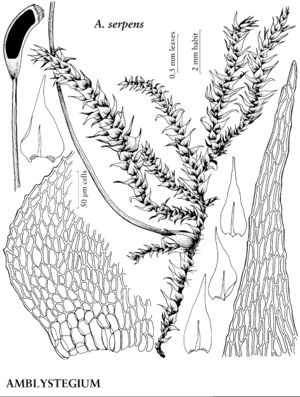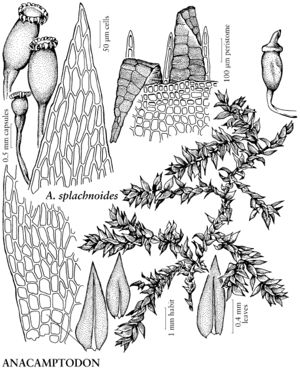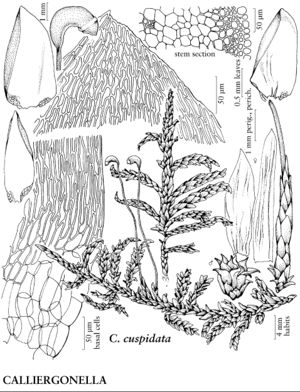Amblystegiaceae
Plants small to large, green, yellowish, or brownish. Stems distichously branched, sometimes almost unbranched; hyalodermis present or absent, cortical cells small, walls incrassate; paraphyllia present or absent; pseudoparaphyllia usually foliose, outer occasionally filamentous; rhizoids or rhizoid initials on stem at or just below leaf insertions or from proximal abaxial costa, occasionally from lamina near apex (Conardia), rhizoids red-brown, slightly or strongly branched, smooth or warty-papillose, rarely granular-papillose; axillary hairs usually well developed. Stem leaves straight, falcate, or squarrose, plicate or not; costa single, usually long, or double and usually short; alar cells differentiated or not, sometimes inflated; medial laminal cells linear or short-linear, rarely rectangular or hexagonal, 1-stratose or sometimes partially 2- or multistratose, smooth or rarely prorate or papillose. Perichaetia with inner leaves erect, straight, lanceolate, ovate, oblong, or slightly obovate, plicate or rarely not, margins entire or partly denticulate, apex usually acuminate, costa single or double, usually well developed, laminal cells usually smooth; paraphyses present. Seta long or rarely short, smooth. Capsule horizontal to erect, cylindric or short-cylindric, curved to straight; stomata with long pores; annulus separating or not; operculum conic, rarely rostrate or short-rostrate; peristome perfect or specialized; perfect exostomes yellow-brown or brownish, external surface cross striolate or sometimes reticulate proximally, papillose distally, margins dentate or slightly dentate, border ± widened at transitional zone in outer peristomial layer pattern; specialized exostome teeth variously narrow or short, external surface sometimes papillose basally; perfect endostome basal membrane high, segments long, not or narrowly perforate, cilia nodose or sometimes appendiculate; specialized endostome basal membrane ± reduced or sometimes absent, segments narrower, sometimes shorter than in perfect endostomes, cilia short to absent. Calyptra cucullate, smooth.
Distribution
Nearly worldwide, temperate to subpolar regions, tropical mountains.
Discussion
Genera 20–30, species 100–150 (20 genera, 57 species in the flora).
Amblystegiaceae as here circumscribed include several genera or species groups that may not or are even unlikely to belong to this family in a strict sense. These include Calliergonella, Campylophyllum, Conardia, most of Hygrohypnum, Limbella, Platydictya jungermannioides, Platylomella, Sanionia, and Tomentypnum. The genus Amblystegium is here understood in a broad sense, including Hygroamblystegium but excluding Serpoleskea (here treated in Platydictya).
Amblystegiaceae is sometimes confused with other pleurocarpous families, such as Brachytheciaceae and Plagiotheciaceae. Most Brachytheciaceae and Plagiotheciaceae differ from Amblystegiaceae in their non-plicate and often recurved, rather than plicate and erect, inner perichaetial leaves (in species with horizontal capsules). In Brachytheciaceae, horizontal capsules are swollen rather than cylindric, the stomata round-pored rather than long-pored, and the exostome base is mostly red or brown-red rather than yellow-brown. The exostome teeth borders are gradually narrowed upwards rather than suddenly widened where the exterior pattern of the teeth changes from cross striolate to papillose, the endostome segments are widely rather than narrowly perforate, and the spores mature in winter rather than summer in temperate areas. Plagiotheciaceae members have pale whitish yellow exostomes and differ from Amblystegiaceae in several diagnostic gametophyte features, including rhizoid position and ornamentation, and branching mode (see 4. Platydictya treatment).
Selected References
Lower Taxa
Illustrations
Key
| 1 | Limbidia usually conspicuous | > 2 |
| 1 | Limbidia absent | > 3 |
| 2 | Limbidia (2-)4-stratose; margins serrulate to serrate, occasionally entire; stems coarse, often dendroid, irregularly branched to subpinnate beyond ± naked stem; paraphyllia absent. | Limbella |
| 2 | Limbidia 2-4-stratose; margins serrulate distally or to base, sometimes entire; stems fine, prostrate, irregularly branched or subpinnate; paraphyllia present. | Platylomella |
| 3 | Stems with hyalodermis at least partial | > 4 |
| 3 | Stems with hyalodermis absent | > 6 |
| 4 | Stem leaves usually plicate; costae single, ending in acumen. | Sanionia |
| 4 | Stem leaves not plicate; ecostate, costae double and short, or sometimes single and long | > 5 |
| 5 | Plants in or near running water or lakeshores; costae single, to 1/2-3/4 leaf or double and short; if double and short, medial laminal cells 27- 66 µm. | Hygrohypnum |
| 5 | Plants in moist and humid habitats; costae double and short, or ecostate; medial laminal cells 42-115(-145) µm. | Calliergonella |
| 6 | Stem leaf alar cells not or poorly differentiated; costae single | > 7 |
| 6 | Stem leaf alar cells ± differentiated or not; costae single or double, occasionally ecostate | > 8 |
| 7 | Plants yellow to dark green or blackish; leaves not plicate; rhizoids sparsely branched, never from abaxial costa surface. | Hygroamblystegium |
| 7 | Plants golden to yellow-green or golden brown; leaves strongly plicate; rhizoids strongly branched, from proximal abaxial costa surface. | Tomentypnum |
| 8 | Stem leaves to 1 mm | > 9 |
| 8 | Stem leaves longer than 1 mm | > 17 |
| 9 | Rhizoids or rhizoid initials on stem, abaxial costa surface, or lamina near apex, warty-papillose, strongly branched, often forming tomentum. | Conardia |
| 9 | Rhizoids or rhizoid initials only on stem or abaxial costa insertion, never on lamina, smooth or rarely slightly papillose, slightly to strongly branched, rarely forming tomentum | > 10 |
| 10 | Stem leaves recurved, wide-spreading, or squarrose, at least along some shoot portions; acumina when differentiated distinctly furrowed | > 11 |
| 10 | Stem leaves not recurved, wide-spreading, or squarrose; acumina plane or almost so | > 14 |
| 11 | Stem leaf costae usually double, short, terminal abaxial spine often present; distal laminal cells usually prorate distally on dorsal side | > 12 |
| 11 | Stem leaf costae single, long, sometimes double and shorter in some (rarely all) leaves, terminal abaxial spine absent; distal laminal cells smooth | > 13 |
| 12 | Leaf acumina not differentiated; apices acute or blunt. | Hygrohypnum |
| 12 | Leaf acumina usually clearly differentiated; apices acuminate or narrowly so. | Campylophyllum |
| 13 | Widest alar cells 10-18(-21) µm wide; paraphyllia absent; sexual condition dioicous; endostome cilia nodose or partially appendiculate. | Campyliadelphus |
| 13 | Widest alar cells 14-25 µm wide; paraphyllia often present; sexual condition autoicous; endostome cilia nodose. | Pseudocampylium |
| 14 | Plants aquatic or semiaquatic; leaves orbicular, broadly ovate, or ovate; if ovate, either apices broadly rounded or alar cells well differentiated. | Hygrohypnum |
| 14 | Plants terrestrial (sometimes on shores); leaves usually ovate to oblong-lanceolate, rarely lanceolate; apices acuminate; alar cells differentiated or not | > 15 |
| 15 | Ecostate or costae double. | Platydictya |
| 15 | Costae single | > 16 |
| 16 | Capsules straight, erect; exostome teeth short, papillose throughout; endostome basal membranes absent, cilia absent; usually epiphytes on trees, sometimes rotten wood. | Anacamptodon |
| 16 | Capsules arcuate, inclined to horizontal; exostome teeth well developed, external surface cross striolate basally; endostome basal membranes present, cilia usually well developed; growing on soil, rock, or wood. | Amblystegium |
| 17 | Stem leaves recurved, wide-spreading, or squarrose, at least along some shoot portions; acumina distinctly furrowed | > 18 |
| 17 | Stem leaves not recurved, wide-spreading, or squarrose; acumina plane or furrowed | > 21 |
| 18 | Stem leaves to 1.7 mm; bases clearly decurrent; alar cells slightly inflated, widest alar cells 10-25 µm wide | > 19 |
| 18 | Stem leaves usually at least 1.6 mm; bases not or hardly decurrent; alar cells strongly inflated, widest alar cells 17-32 µm wide | > 20 |
| 19 | Widest alar cells 10-18(-21) µm wide; paraphyllia absent; sexual condition dioicous; endostome cilia nodose or partially appendiculate. | Campyliadelphus |
| 19 | Widest alar cells 14-25 µm wide; paraphyllia often present; sexual condition autoicous; endostome cilia nodose. | Pseudocampylium |
| 20 | Stem leaf costae double or single, ending below mid leaf; alar regions quadrate, ovate, or rectangular, reaching from margin 15-60% distance to costa at insertion. | Campylium |
| 20 | Stem leaf costae double and short or single and long; alar regions transversely triangular or quadrate, reaching from margin (25-)40-100% distance to costa at insertion. | Drepanocladus |
| 21 | Paraphyllia usually present; rhizoids often forming tomentum | > 22 |
| 21 | Paraphyllia absent; rhizoids rarely forming tomentum | > 24 |
| 22 | Stem leaves plicate; at least some medial laminal cells usually prorate or rarely papillose abaxially; paraphyllia linear or lanceolate-linear. | Palustriella |
| 22 | Stem leaves not plicate; medial laminal cells smooth; paraphyllia ± lanceolate | > 23 |
| 23 | Sexual condition dioicous; alar cells hyaline, inflated; stem leaves usually triangular; margins denticulate or serrulate. | Cratoneuron |
| 23 | Sexual condition autoicous; alar cells green to brownish orange, not or slightly inflated; stem leaves oblong-lanceolate to oblong-ovate, rarely ovate; margins entire to finely denticulate. | Hygroamblystegium |
| 24 | Stem leaf costae double or 2-fid, short, or ending in mid leaf to slightly beyond | > 25 |
| 24 | Stem leaf costae single, long | > 26 |
| 25 | Alar cell walls thin or slightly incrassate, regions mostly well delimited, small, quadrate or rectangular; axillary hairs hyaline when young. | Hygrohypnum |
| 25 | Alar cell walls ± strongly incrassate, regions indistinctly delimited, large, transversely triangular; axillary hairs yellow or brownish when young. | Pseudocalliergon |
| 26 | Stem leaf alar regions distinctly delimited | > 27 |
| 26 | Stem leaf alar regions indistinctly or gradually delimited | > 28 |
| 27 | Alar cells not or slightly inflated; plants frequently in running water or on wet rock. | Hygrohypnum |
| 27 | Alar cells strongly inflated; plants not usually in running water. | Drepanocladus |
| 28 | Rhizoids or rhizoid initials on abaxial costa surface or on lamina near apex, warty-papillose, strongly branched, often forming tomentum. | Conardia |
| 28 | Rhizoids or rhizoid initials only on stem or abaxial costa insertion, never on lamina, smooth or rarely warty-papillose, slightly to strongly branched, rarely forming tomentum (often forming tomentum in Hygroamblystegium) | > 29 |
| 29 | Stem leaf alar cell walls usually incrassate to strongly so, rarely thin in mature leaves; axillary hairs well developed, many, distal cells yellow or brownish when young. | Pseudocalliergon |
| 29 | Stem leaf alar cell walls thin or slightly incrassate in mature leaves; axillary hairs well developed and many, or small, delicate, sparse, distal cells hyaline when young | > 30 |
| 30 | Leaf apices rounded or blunt; costae ending 1/2 -3/4 leaf length. | Hygrohypnum |
| 30 | Leaf apices acuminate, if blunt or obtuse then costae ending in or just before apex | > 31 |
| 31 | Stem leaf costae to 3/5 -3/4 leaf length; medial laminal cells 42-117 µm. | Leptodictyum |
| 31 | Stem leaf costae usually ending in distal acumen to percurrent; medial laminal cells (9-)13-65(-67) µm. | Hygroamblystegium |


